We recognize that Disney vacations are not just an investment, but often the highlights of our lives, and we take that responsibility seriously. We want to ensure you have the best vacation experience. Interested in a job in travel? Click here to learn: How to Become a Disney Travel Agent
Jump to section: A B C D E F G H I J K L M N O P Q R S T U V W X Y ZSee our Disney travel agents near me.
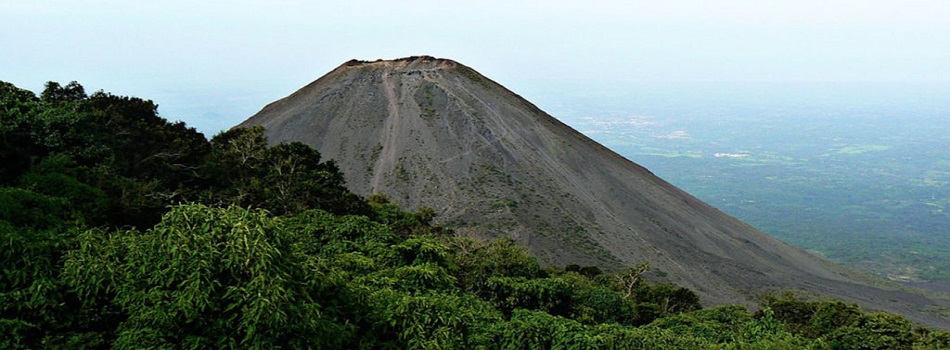
Renowned for its Pacific Ocean beaches, surfing, lush landscapes, and pristine natural habitats, El Salvador is an eco-traveler’s paradise that is also known as the Land of Volcanoes for having 25 visible volcanoes. At approximately 8,108 square miles, which is roughly the size of the state of Massachusetts, El Salvador is the smallest country in Central America, sharing borders with Guatemala and Honduras in the southeast region of the Mesoamerica, and the only country in the region without coastline on the Caribbean Sea. Its centrally situated capital, San Salvador, is a diverse city known for business, a vibrant nightlife, and emerging art scene. The summit of Monte Cristo Mountain is one of the highest point, offering a nature preserve and cloud forest. Among El Salvador’s most popular tourist destinations are two vast national parks – El Impossible and Parque Nacional Los Volcanoes, which contains about 500 species of birds and mammals. Other popular attractions are Ruta de Las Flores, a winding journey past flowering coffee farms and rainforest zip-line sites; colonial towns like Juayúa, with its weekend food festival; Ataco, home to vivid murals; and Playa El Tunco, a surfing village with black sand beaches
Valid passport needed for entry. Additionally, upon arrival a visa will need to be purchased for $10 which is valid for 90 days.
Spanish is the primary written and spoken language throughout the country. In tourist areas and attractions, some English is spoken.
The legal tender for all transactions is the United States Dollar. Most businesses accept dollar bills in small denominations, generally not larger than $50 USD. It is recommended to carry cash for local shops, while hotels, major stores, and high-end restaurants accept credit cards.
El Salvador has a tropical climate with small annual changes in temperature. The country has two seasons, the dry season – which goes from November until April, and the rainy season – which goes from May until October.
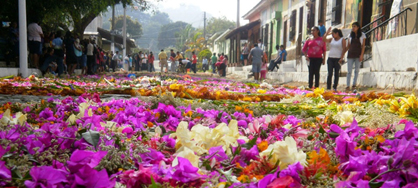
Goes through the impressive Apaneca-llamatepec mountain range, visiting artisan towns with traditional culture such as Nahuizalco, Salcoatitan, Juayua (known as the city of food festivals), Apanceca (which boasts coffee forests and lagoons), Concepcion de Ataco (a beautiful city with cobblestone roads and tepid climate), and Ahuachapan (a charming city rich with history, traditions, coffee plantations, and the natural wonders of geysers and a beautiful lagoon).
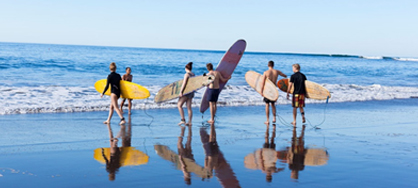
Covers 186 miles of amazing beaches, warm waters, and rocky reefs all perfect for swimming, scuba diving, snorkeling, surfing, and other water activities. The trail includes two of the best surfing spots in the world: El Sunzal and Punta Roca. Along this highly popular trail visitors will find an array of hotels, eco-lodges, marinas, restaurants, and viewing decks with convenient access.
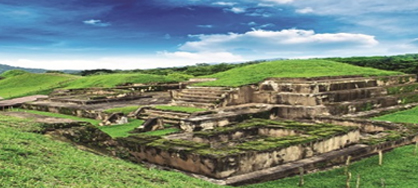
San Andrés is the site of the capital of Mayan dominion that was spreading along the Zapotitán Valley between 600 and 900 AD. While the first settlement took place around 900 BC, settlers probably left the town by 250 BC because of the eruption the Ilopango Lake Cauldron. During the 5th century AD, it would be occupied again by native Indians. The first major excavation occurred in the 1940s.
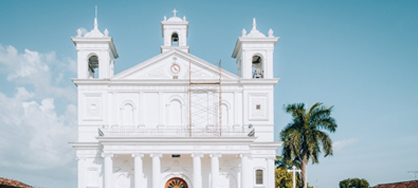
Located 31 miles northeast of San Salvador, wondrous little 'Suchi' is the cultural capital of the country. Every weekend, the cobbled streets come alive for an arts and food festival in a grand celebration of guanaco pride. The month of February is dedicated to celebrating the town's resident artists, and the small galleries swell with domestic tourists. Historically, indigo ruled the area and was the key driver of the economy before a synthetic component was created. Today, visitors can still learn the original organic way indigo was used to create vibrant apparel. Architecture buffs will love the colonial buildings, while outdoor types can choose between numerous hikes to waterfalls, caves, and beautiful Lago Suchitlán, all within miles of town.

El Salvador serves up some of the best food in Central America, but it’s about more than just the flavors. Even in the most modest mercados, you’ll also find serious attention to detail. The focus is on fresh ingredients and complex recipes handed down through generations. Even better, you’ll often enjoy your meals in beautiful surroundings, with good music, lavish gardens, and other aesthetic extras.
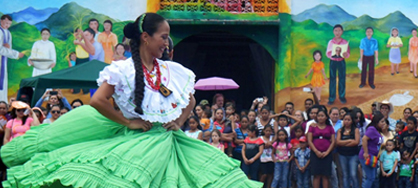
While larger festivals provide the most colorful backdrops, even smaller events—like the food festival in Juayúa and the artisan market in Suchitoto, both held every weekend—are authentic expressions of this country’s unique culture. Plus, many other cities hold weekend culinary and handicraft fairs, and every town celebrates its patron saints with a big annual party, called a fiesta patronal.
El Salvador is not a country for pessimists. This small land has endured more than its share of war, poverty and natural disasters. And you'll see the scars of these—if that's what you're looking for. But look a little closer and you'll also see the resilience and optimism such tragedy can inspire.
Poor communities such as Ilobasco and La Palma have become renowned for their handicrafts and folk art. The National Civilian Police (PNC) are earnest about improving the safety of the country. Volcanic eruptions may have wiped out whole villages, but one around AD 600 preserved the ancient Maya community of Joya de Ceren for today's tourists.
For the greatest safety, we recommend seeing El Salvador as part of one or more organized tours. In addition to making your visit a safer one, a tour will help you to gain a better understanding of the country's major attractions. They include volcanoes and mountains (especially those in Cerro Verde National Park), the beaches of Costa del Sol, tropical nature preserves (El Imposible and Montecristo National Parks) and archaeological sites.
The Maya were present in western El Salvador for more than 1,000 years before Europeans arrived. They created several pyramids that can still be seen today and were in close contact with the Maya who inhabited other parts of Central America and Mexico. Their civilization had declined by the early 1500s, however, and several other indigenous groups, including the Pipil, were living in El Salvador at the time Europeans arrived on the North American mainland.
In 1524, Spanish conquistador Pedro de Alvarado, a lieutenant of Cortez, swept south from Mexico with 400 men and conquered Central America. El Salvador became part of the Captaincy of Guatemala. Various crops were cultivated on the Spanish estates, including cocoa, balsam and indigo. In 1821, as Mexico and Central America became independent of Spain, El Salvador and several other Central American countries formed the United Provinces of Central America. El Salvador broke free of the union in 1839, becoming an independent nation.
In the years that followed, the country suffered from political turmoil and a burgeoning population. Conservatives and radicals, under various guises and names, opposed each other while the Catholic Church first supported one side and then the other. Peasants, by far the majority of the population, were stuck in the middle. Coffee became the country's most lucrative crop, and land was concentrated into the hands of a small, powerful oligarchy. A peasant uprising in 1932 was brutally suppressed.
The civil war of the 1980s stemmed from the land inequities, as well as contested elections in the 1970s. A spark that escalated it was the 1980 killing of Archbishop Oscar Romero by right-wing assassins. (Romero had been an outspoken defender of the poor.) The leftist FMLN (Frente Marti Liberacion Nacional) rebels began a guerrilla war against the government and received support from the Soviet bloc. The U.S.—fearing another successful revolution like the one in Nicaragua—sent military aid to help the government. Right-wing death squads, who also opposed the rebels, killed and tortured thousands of civilians. Guerrilla forces, in turn, kidnapped members of the wealthy elite and demanded huge ransoms to support their fighting. After 12 years of fighting and some 75,000 deaths, the conflict came to an end in 1992 with the signing of a U.N.-brokered peace accord. Despite peace, the establishment of democracy and a redistribution of land, El Salvador remains a poor country grappling with overpopulation, environmental degradation and an abundance of weapons left over from the war.
Natural disasters have also hindered El Salvador's development. Hurricane Mitch caused widespread flooding in 1998, and two devastating earthquakes occurred in recent years. A massive quake in 2001 killed more than 1,000 people and destroyed some 145,000 homes. El Salvador adopted the U.S. dollar as its official currency in 2001 as part of plans to stabilize its economy and attract foreign investment.
El Salvador's main attractions include lakes, Maya ruins, gray-sand beaches, volcanoes, deep-sea fishing, colonial towns, handicraft villages, birding, tropical forests, rugged coastal scenery and genuinely warm and friendly people.
Experienced travelers interested in Central American ruins and culture and those who don't mind the difficulties of visiting a developing nation will enjoy El Salvador. Those looking for a less-demanding introduction to the region should consider other countries in Central America, such as Costa Rica or Belize.
El Salvador's civil war destroyed forests as well as families. A group in Guazapa, in northern El Salvador, is trying to heal both wounds with a project called the National Forest of Reconciliation. The group's aim is to plant one tree in memory of each of the approximately 75,000 people killed in the war. The forest, now covering more than 110 acres/45 hectares, is on the slopes of Guazapa Volcano.
Because of its rolling, green countryside, El Salvador is sometimes called "the Ireland of Central America."
El Salvador is one of the world's largest producers of coffee. October and November is coffee-picking season.
The Lempa River, source of 70% of the country's drinking water and electric power, is seriously polluted. The scarcity of safe drinking water is a major concern in the country.

Salvador, Brazil's coastal former capital, is a striking city 750 mi/1,200 km northeast of Rio de Janeiro. It lies on the beautiful Bay of All Saints (Bahia de Todos os Santos), the second-largest bay in the country. There is a strong African influence derived from the slaves brought to work in the sugarcane fields more than 400 years ago.
Salvador is divided into an Upper Town and a Lower Town; both are linked by the art-deco Lacerda elevator, which offers outstanding views. The Pelourinho is the largest intact colonial center in the Americas. Its twisting, narrow cobblestoned streets are lined with pastel mansions and stunning baroque churches and convents. Colorful open-air markets, an amazing array of popular and religious festivals (including Afro-Brazilian Candomble ceremonies) and fantastic beaches make this an excellent place to stay for two or three nights.
No tour of the city is complete without seeing the Igreja de Sao Francisco—although it's relatively plain on the outside (as are most Portuguese churches in Brazil), the inside is covered in gold leaf and is as ornate as it is beautiful. Also visit the Farol da Barra, a 16th-century fortified lighthouse that overlooks the Bay of All Saints and the island of Itaparica.
The Igreja do Bonfim is where believers from the northeast go to worship and pay for the promises they made in return for miracles (don't miss the Room of Miracles, where pilgrims leave wooden, silver or wax replicas of body parts in need of miraculous healing—you'll be amazed by the number of arms, legs, heads, hearts and lungs dangling from the ceiling). Dozens of other stunning colonial churches are sprinkled throughout Salvador's center and colonial district, including the Cathedral Igreja Nossa Senhora Rosario dos Pretos (built by and for slaves), Igreja do Carmo and Igreja Nossa Senhora da Conceicao.
Shopping is good at boutiques in the Barra and Pelourinho neighborhoods, as well as at shopping malls such as Barra and Iguatemi. The touristy Mercado Modelo is great for small, kitschy souvenirs. The chaotic but colorful Sao Joaquim market has interesting and authentic Afro-Brazilian artifacts.
You can see other reminders of the city's past at the Museu Carlos Costa Pinto and the Museu de Arte Sacra. The city's culture is celebrated in the Museu da Cidade (Yoruba tribal displays) and the Afro-Brazilian Museum (with good explanations about Afro-Brazilian religions). Try to attend a candomble religious ceremony at a traditional house or terreiro, and watch capoeira, an amazing combination of martial arts and African folk dance (don't take pictures of the participants unless you are willing to pay for the privilege).
Salvador also has a great Carnival celebration. Billed as the largest street party in the world, it is seven days of nonstop revelry that has grown so big it threatens to eclipse even Rio de Janeiro's Carnival.
North of Salvador are the lovely fishing villages and beaches of the Coconut Coast, including Arembepe, Imbassai and the more upscale Praia do Forte, which borders the Sapiranga Ecological Reserve. The reserve protects one of Brazil's last areas of ancient Atlantic rain forest. Itaparica, a lush island 12 mi/19 km southwest, has several nice beaches and a great view of Salvador across the bay. Every hour, the Sao Joaquim Ferry makes the 45-minute crossing. A high-speed launch also makes the trip in 15 minutes.
Note: Salvador has more than its share of poverty and crime. When you're having a soda or beer in an open bar or cafe (particularly in the Pelourinho), be prepared for beggars with cups or glasses to ask you for a drink. Crime directed at tourists can be a problem. However, both the Pelourinho and the beaches at Barra are well-supervised by special tourist police. For safety's sake, however, dress simply and take taxis after dark.
The capital of El Salvador and its largest city, San Salvador is a bustling place with massive traffic jams during rush hour. The ongoing construction of expressways adds to the slowdowns.
Though it was established in 1546, most of San Salvador's colonial buildings were destroyed by various earthquakes, floods and a volcanic eruption. As a result, it has a modern appearance.
Vincent Vacations - Authorized Salvador Vacation Planner
Questions? Call us at
1 (888) 976-0061
For Groups of 10
or more rooms, or 8 or more Cabins, please use of Group Form
Click Here for our Group Department
From our storefronts to your destination, we are your dedicated, debt-free, and experienced travel partner.
We are a proud USA-based, 100% female-owned business. Operating completely debt-free, we offer you the stability and peace of mind you deserve when booking your dream vacation.
As a Top 20 Agency with the elite Signature Travel Network, we unlock exclusive perks, upgrades, and amenities for you that you can't find anywhere else.
Serving clients since 2013 with leadership selling travel since 2002. Our team of professionals brings decades of real-world travel experience to your itinerary.
While we have physical storefront locations you can visit, we are fully equipped to book travel for clients residing in every state across the USA.
We are a company that can be trusted. We advocate for you from the moment you book until you return home, ensuring a seamless experience.
Click on a location below to learn more. We recognize that vacations are not just an investment, but often the highlights of our lives, and we take that responsibility seriously. We want to ensure you have the best experience.

All of these are signs that you are a great fit to become an independent travel agent, and turn your love of travel from passion into profit!
Learn MoreOur motto at Vincent Vacations is, we go so you know! We want to ensure you have the BEST experience, whether it's a river cruise, or a corporate group incentive trip, we want to ensure your vacation is a success.
We serve customers all across the USA
Debt free and in business since 2013. Vincent Vacations has agents in Dallas, Kansas City, Houston, Shreveport, Little Rock, Roswell, Oklahoma City and more locations.

Travel agents can help save time and stress by doing the research and handling all your bookings for you. An experience travel agent is best at finding great deals and packages, as well as providing you with helpful information and tips. They can also help you plan special activities and experiences that you may not have thought of on your own. All in all, using a travel agent can be a great way to make sure you get the most out of your trip.
In travel since 2002, and in business since 2013, our travel team serves clients all over the US! Planning a vacation away from home takes a great team. We have taken the time to build a team of dedicated, smart, hard-working personnel who are each committed to excellence and service. We work side-by-side, creating and ensuring INCREDIBLE vacation experiences for you and your group. Our store front in-office team, and our travel consultant independent contractors, work all around the US.


In business since 2013, we are your #1 source for travel!
Free Vacation Package Quote